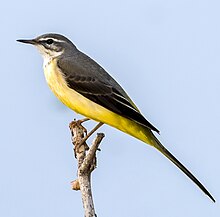灰鶺鴒
| 灰鹡鸰 | |
|---|---|

| |
| 印度海德拉巴的灰鹡鸰
| |
| 科学分类 | |
| 界: | 动物界 Animalia |
| 门: | 脊索动物门 Chordata |
| 纲: | 鸟纲 Aves |
| 目: | 雀形目 Passeriformes |
| 科: | 鹡鸰科 Motacillidae |
| 属: | 鹡鸰属 Motacilla |
| 种: | 灰鹡鸰 M. cinerea
|
| 二名法 | |
| Motacilla cinerea Tunstall, 1771
| |

| |
| 灰鹡鸰的分布范围 繁殖季 留鸟 非繁殖季
| |
| 異名 | |
|
Motacilla melanope | |
灰鶺鴒(學名:Motacilla cinerea)为鶺鴒科鶺鴒屬下的一种鳥類。[2]這個物種主要在蒙古、中國大陸北部、朝鮮半島、日本、俄羅斯繁殖;在中國大陸南部、臺灣、菲律賓、中南半島、印尼等地過冬。[3]
全長約18-19公分。該物種看起來與黃鶺鴒有些相似,但其下腹部的黃色僅限於喉部和泄殖腔。繁殖期的雄鳥有黑色喉部,而雌鳥則有更多白色區域。其性別及冬夏間的羽色略有不同。[4]。
該物種分布廣泛,幾個種群在古北界的歐亞大陸繁殖,並遷徙至亞洲和非洲的熱帶地區。繁殖時,牠們一般與流水相關,雖然牠們可能會利用溪流附近的人造建築來築巢。非繁殖季節時,牠們也可見於湖泊、海岸及其他水域棲地。相對於黃鶺鴒,這種鳥類更偏好山區活動。[5][3]與其他鶺鴒類似,牠們經常搖動尾巴,飛行時呈波浪狀,並且在飛行中經常發出尖銳的叫聲。


分類與系統學
[编辑]灰鶺鴒的二名法Motacilla cinerea由馬馬杜克·唐斯塔爾於1771年在其著作《英國鳥類學》Ornithologia Britannica中首次介紹。[6][7] Motacilla是拉丁語中對灰鶺鴒的名稱;儘管實際上是motare的指小詞,意思是「移動」,但在中世紀時代引發了對cilla為「尾巴」的誤解。種小名cinerea來自拉丁語cinis,意為「灰燼」,指「灰色」。[8]
該物種的親緣關係尚未完全解決;它屬於非洲鶺鴒之外的分支,這些物種在外部形態上令人困惑,mtDNA細胞色素b與NADH脫氫酶亞基2的序列數據無法穩健地解決其親緣關係。雖然現有物種可能與黃頭鶺鴒和一些西方黃鶺鴒最為接近,但其確切的關係仍不明確。[9]
- M. c. patriciae(沃里,1957) – 亞速爾群島
- M. c. schmitzi(楚西,1900) – 馬德拉群島
- M. c. cinerea(唐斯塔爾,1771) – 西歐、加那利群島與西北非洲至中部、東部和東北亞
描述
[编辑]
這種纖細的鶺鴒有狹窄的白色眉紋和斷裂的眼環。上半身為灰色,與白色下腹部形成對比的黃色泄殖腔使其具有辨識度。繁殖期雄鳥有黑色喉部,邊緣有白色的鬍鬚狀條紋。牠們通常單獨或成對在草地或淺水沼澤地覓食,也會使用水中的岩石,並經常棲息在樹上。牠們的叫聲清脆尖銳,歌聲由顫音組成。[11]
分布與棲地
[编辑]灰鶺鴒廣泛分布於古北界地區,具有數個明顯的種群。指名型(包括caspica,分布於伊朗、土耳其和高加索地區)來自西歐,包括不列顛群島、斯堪地那維亞和地中海地區。melanope亞種主要分布在東歐和中亞,主要沿著烏拉爾山脈、天山山脈和喜馬拉雅山脈繁殖,與指名亞種之間的區分並不明顯。[12] 牠們在非洲和亞洲過冬。robusta亞種在亞洲東北部的西伯利亞繁殖,分布範圍延伸至韓國和日本,這些亞種在東南亞過冬。島嶼型包括亞速爾群島的patriciae、馬德拉群島的schmitzi及加那利群島的canariensis。
牠們有時會出現在阿拉斯加西部的島嶼上,但已知有時作為迷鳥出現在更南的加利福尼亞。[13]
行為與生態
[编辑]
繁殖季節從四月到七月,巢築在快速流動的溪流或河流旁的堤岸上,位於石頭和樹根之間。[11] 雄鳥在展示時會短暫飛向空中,然後慢慢下降,伴隨著一系列快速的尖銳高音。[14] 在歐洲,巢穴通常築於人工結構中的洞穴中。每窩產下3至6顆帶有斑點的蛋,可能會多次繁殖,但後續每窩蛋的數量會逐漸減少。[15] 在愛爾蘭,通常每窩產五顆蛋,繁殖成功率約為80%,蛋或雛鳥的捕食是主要的繁殖失敗原因。[16] 加那利群島的種群通常每窩蛋數較少,且繁殖季節沒有較高緯度地區那麼短且明顯。[17] 孵卵期約兩週,雛鳥在孵化後兩週內羽化。野外的壽命最長可達8年。[18][19]
在其分布區的一些地區,白喉河烏與灰鶺鴒共享相同的棲地,並且有一些異種哺育的紀錄,即成鳥灰鶺鴒為河烏的雛鳥餵食。[20]
這些鳥類捕食各種水生無脊椎動物,包括成蟲蒼蠅、蜉蝣、甲蟲、甲殼類和軟體動物。[21] 牠們在冬季經常沿著路邊覓食,發出尖銳的chi-cheep叫聲,飛向路邊更遠的地方,但飛行一段距離後又會折返至原地。[14]
在冬季,牠們會成小群過夜。[22] 已知過冬的鳥類每年會回到同一地點,有時會選擇一個小的城市花園。[14][23]
成鳥經常受到寄生蟲蜱Ixodes ricinus的感染,這些蜱可以攜帶Borrelia,因此可能在廣泛區域內傳播萊姆病。[24] 此物種中也已知存在球蟲病,如Isospora。[25]大杜鵑有時會對該物種進行巢寄生,[26] 而紅隼有時會捕食牠們。[27]
參考資料
[编辑]- ^ BirdLife International. Motacilla cinerea (amended version of 2016 assessment). The IUCN Red List of Threatened Species 2017: e.T22718392A111215843. [2024-05-27]. doi:10.2305/IUCN.UK.2016-3.RLTS.T22718392A111215843.en
 .
.
- ^ International Ornithologists' Union. Gill, Frank; Donsker, David; Rasmussen, Pamela , 编. IOC World Bird List 14.1. [2023-12-20] (英语).
- ^ 3.0 3.1 灰鶺鴒. 陽明山國家公園全球資訊網-中文網. [2024-05-27]. (原始内容存档于2024-05-27) (中文(臺灣)).
- ^ 劉小如; 丁宗蘇; 方偉宏; 林文宏; 蔡牧起; 顏重威. 台灣鳥類誌第二版(下). 台灣: 行政院農業委員會林務局. 2012-12-01: 526—528 [2023-08-18]. ISBN 9789860339277. (原始内容存档于2020-05-20) (中文(臺灣)).
- ^ 灰鶺鴒. 衛生福利部國家中醫藥研究所. [2024-05-27]. (原始内容存档于2024-05-27).
- ^ Schodde, R.; Bock, W.J. The valid name for the Grey Wagtail. Bulletin of the British Ornithologists' Club. 2008, 128 (2): 132–133.
- ^ Tunstall, Marmaduke. Newton, Alfred , 编. Tunstall's Ornithologia britannica. London: J. Akerman. 1880: 2 [1771] (拉丁语). A photo-lithographic reproduction of the original publication.
- ^ Jobling, James A. The Helm Dictionary of Scientific Bird Names. London, United Kingdom: Christopher Helm. 2010: 107, 261. ISBN 978-1-4081-2501-4.
- ^ Voelker, Gary. Systematics and historical biogeography of wagtails: Dispersal versus vicariance revisited. Condor. 2002, 104 (4): 725–739. S2CID 85844839. doi:10.1650/0010-5422(2002)104[0725:SAHBOW]2.0.CO;2
 .
.
- ^ Gill, Frank; Donsker, David; Rasmussen, Pamela (编). Waxbills, parrotfinches, munias, whydahs, Olive Warbler, accentors, pipits. IOC World Bird List Version 11.1. International Ornithologists' Union. January 2021 [3 June 2021].
- ^ 11.0 11.1 Rasmussen PC; Anderton, JC. Birds of South Asia: The Ripley Guide. Volume 2. Smithsonian Institution & Lynx Edicions. 2005: 317.
- ^ Hume, AO. The nests and eggs of Indian Birds. Volume 2.. R H Porter, London. 1890: 207.
- ^ Checklist of Alaska birds (PDF) 15th. University of Alaska, Fairbanks. 2009 [30 October 2009].
- ^ 14.0 14.1 14.2 Ali, S; Ripley, S D. Handbook of the birds of India and Pakistan. Volume 9 2nd. 1998: 290–292.
- ^ Klemp S. Effects of parental effort on second brood, moult and survival in the Grey Wagtail Motacilla cinerea. Ardea. 2000, 88 (1): 91–98.
- ^ Smiddy, P.; O'Halloran, J. Breeding biology of the Grey Wagtail Motacilla cinerea in southwest Ireland. Bird Study. 1998, 45 (3): 331–336. doi:10.1080/00063659809461104.
- ^ Rodríguez B.; Rodríguez A. Breeding biology of Grey Wagtail Motacilla cinerea canariensis on Tenerife, Canary Islands (PDF). Acta Ornithol. 2007, 42 (2): 195–199 [2009-10-28]. doi:10.3161/068.042.0203
 . (原始内容 (PDF)存档于2016-03-04).
. (原始内容 (PDF)存档于2016-03-04).
- ^ Robinson, R.A. BirdFacts: profiles of birds occurring in Britain & Ireland. BTO Research. 2005 [28 October 2009].
- ^ Jørgensen OH. Migration and Aspects of Population Dynamics in the Grey Wagtail Motacilla cinerea. Ornis Scandinavica. 1976, 7 (1): 13–20. JSTOR 3676170. doi:10.2307/3676170.
- ^ Yoerg, SI; O'Halloran, J. Dipper Nestlings Fed by a Gray Wagtail (PDF). Auk. 1991, 108 (2): 427–429.
- ^ Santamarina, Jesus. The Grey Wagtall (Motacilla cinerea) diet in the Ulla river basin, Galicia. NW Spain (PDF). Ardeola. 1989, 37 (1): 97–101 (西班牙语).
- ^ Neelakantan, KK. Roosting of the Grey Wagtail [Motacilla caspica (Gmelin)] in the Thekkady Wild Life Sanctuary. J. Bombay Nat. Hist. Soc. 1964, 61 (3): 691–692.
- ^ Nickell, Walter P. Return of Northern Migrants to Tropical Winter Quarters and Banded Birds Recovered in the United States. Bird-Banding. 1968, 39 (2): 107–116. JSTOR 4511469. doi:10.2307/4511469.
- ^ Dubska, Lenka; Ivan Literak; Elena Kocianova; Veronika Taragelova; Oldrich Sychra. Differential Role of Passerine Birds in Distribution of Borrelia Spirochetes, Based on Data from Ticks Collected from Birds during the Postbreeding Migration Period in Central Europe. Applied and Environmental Microbiology. 2009, 75 (3): 596–602. Bibcode:2009ApEnM..75..596D. PMC 2632145
 . PMID 19060160. doi:10.1128/AEM.01674-08.
. PMID 19060160. doi:10.1128/AEM.01674-08.
- ^ Svobodova, M. Isospora, Caryospora and Eimeria (Apicomplexa: Passeriform Birds from Czech Republic (PDF). Acta Protozoologica. 1994, 33: 101–108.
- ^ Adamík P.; Hušek J.; Cepák J. Rapid decline of Common Cuckoo Cuculus canorus parasitism in Red-backed Shrikes Lanius collurio (PDF). Ardea. 2009, 97 (1): 17–22 [2013-03-29]. S2CID 86228074. doi:10.5253/078.097.0103. (原始内容 (PDF)存档于2016-03-04).
- ^ Costantini, David; Casagrande, Stefania; Di Lieto, Giuseppe; Fanfani, Alberto; Dell'Omo, Giacomo. Consistent differences in feeding habits between neighbouring breeding kestrels (PDF). Behaviour. 2005, 142 (9–10): 1403–1415. doi:10.1163/156853905774539409. (原始内容 (PDF)存档于2007-07-10).
外部連結
[编辑]| 这是一篇與雀形目相關的小作品。您可以通过编辑或修订扩充其内容。 |

